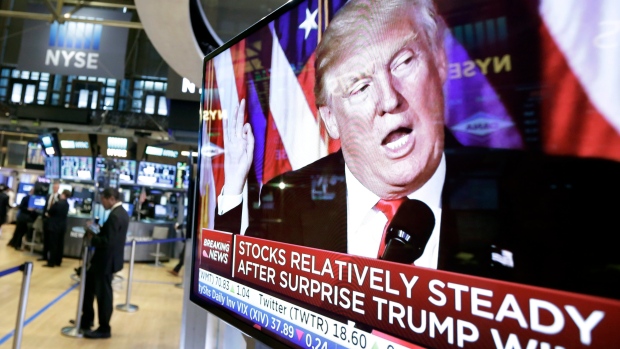Nov 10, 2016
Dow closes at new high as hope for Trump carries into second day
Reuters

U.S. banking sector shares on Thursday surged to levels not seen since the midst of the 2008 financial crisis, pushing the Dow to an all-time high, while technology shares sank as Wall Street rearranged its bets to benefit from Donald Trump's presidency.
The S&P 500 financial sector surged 3.70 per cent to its highest since the 2008 financial crisis, bringing its gain since Trump's surprise victory in Tuesday's election to 7.9 per cent, its biggest two-day gain since 2011.
Shares of Wells Fargo & Co jumped 7.58 per cent to their highest since January, and have now erased all of the losses incurred in the wake of a scandal over fake accounts opened by its employees. Bank of America surged 4.40 per cent and JPMorgan Chase rallied 4.64 per cent to a record high.
Trump has sided with leading conservatives in calling for the repeal of the 2010 Dodd-Frank Financial Reform Act largely opposed by banks.
"The Trump campaign did say it would repeal Dodd-Frank. Rates are higher and the yield curve is steeper. Those are all good things for the banks," said Warren West, principal at Greentree Brokerage Services in Philadelphia.
Apple dropped 2.79 per cent while Amazon.com fell 3.82 per cent and the S&P 500 technology index fell 1.59 per cent.
The Dow Jones industrial average jumped 1.17 per cent to end at 18,807.88, smashing through its previous record high set in August by almost 1 per cent.
The S&P 500 rose 0.2 per cent to 2,167.48 while the Nasdaq Composite dropped 0.81 per cent to 5,208.80, hurt by losses in tech shares.
With Thursday's gain, the Dow is up 8 per cent in 2016 and the S&P 500 is up 6 per cent.
High-dividend sectors utilities, telecom services and consumer staples sold off by more than 2 per cent as bond yields rose due to expectations of higher interest rates.
The market got a lift after St. Louis Federal Reserve President James Bullard said the Republican sweep of the White House and Congress could break the current gridlock over national policy in a potential boon to the U.S. economy.
Industrials trailed the financials with a 2.05 per cent advance.
Macy's rose 5.6 per cent after the department store operator raised its full-year sales forecast and announced a partnership to monetize some of its real-estate assets.
After the bell, Nordstrom reported quarterly results that sent its shares 5 per cent higher while Walt Disney's quarterly report pushed its stock down 2.6 per cent.
Declining issues outnumbered advancing ones on the NYSE by a 1.15-to-1 ratio; on Nasdaq, a 1.58-to-1 ratio favored advancers.
The S&P 500 posted 84 new 52-week highs and seven new lows; the Nasdaq Composite recorded 336 new highs and 48 new lows.
About 12.3 billion shares changed hands on U.S. exchanges, far above the 7.3 billion daily average over the last 20 sessions.
Canada's main stock index dipped on Thursday as lower commodity prices weighed on gold mining and energy stocks, while higher bond yields weighed on defensive sectors, such as utilities, telecoms and consumer staples.
The Toronto Stock Exchange's S&P/TSX composite index closed down 15.66 points at 14,744.25. Seven of the index's 10 main groups ended lower.
The Canadian dollar fell for a second day as it continued to feel pressure from declining oil prices, a stronger U.S. currency and worries about president-elect Donald Trump's plans regarding free-trade agreements.
The loonie lost 0.58 of a U.S. cent to 74.17 cents US, while the December crude contract fell 61 cents to US$44.66 per barrel.
Other commodities were mixed with the December gold contract losing $7.10 to US$1,266.40 an ounce, December natural gas dipping six cents to US$2.63 per mmBTU, and December copper setting a new 15-month record, climbing nine cents at US$2.55 a pound.
Nine of the 12 subgroups closed lower, led by gold at 205.73 points, down 15.74 points, or 7.11 per cent.
Industrials led the advancers, adding 4.57 points, or 2.35 per cent, to 199.45 points.
--With files from the Canadian Press







